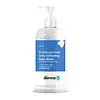What's inside
What's inside
 Key Ingredients
Key Ingredients

 Benefits
Benefits

 Concerns
Concerns

 Ingredients Side-by-side
Ingredients Side-by-side

Water
Skin ConditioningDisodium Laureth Sulfosuccinate
CleansingCocamidopropyl Betaine
CleansingGlycerin
HumectantCaprylyl/Capryl Glucoside
CleansingSodium Methyl Cocoyl Taurate
CleansingCoco-Glucoside
CleansingLauryl Glucoside
CleansingCocamide DEA
EmulsifyingSalicylic Acid
MaskingGlycolic Acid
BufferingSodium Lauroyl Oat Amino Acids
CleansingZinc
AntioxidantPCA
HumectantSaccharide Isomerate
HumectantOlive Oil PEG-7 Esters
EmollientBetaine
HumectantImidazolidinyl Urea
PreservativeMenthol
MaskingMelaleuca Alternifolia Leaf Oil
AntioxidantPolyquaternium-7
Propylene Glycol
HumectantPEG-150 Distearate
EmulsifyingDisodium EDTA
Methylchloroisothiazolinone
PreservativeMethylisothiazolinone
PreservativeWater, Disodium Laureth Sulfosuccinate, Cocamidopropyl Betaine, Glycerin, Caprylyl/Capryl Glucoside, Sodium Methyl Cocoyl Taurate, Coco-Glucoside, Lauryl Glucoside, Cocamide DEA, Salicylic Acid, Glycolic Acid, Sodium Lauroyl Oat Amino Acids, Zinc, PCA, Saccharide Isomerate, Olive Oil PEG-7 Esters, Betaine, Imidazolidinyl Urea, Menthol, Melaleuca Alternifolia Leaf Oil, Polyquaternium-7, Propylene Glycol, PEG-150 Distearate, Disodium EDTA, Methylchloroisothiazolinone, Methylisothiazolinone
Water
Skin ConditioningCocamidopropyl Betaine
CleansingGlycerin
HumectantCaprylyl/Capryl Glucoside
CleansingSodium Methyl Cocoyl Taurate
CleansingDecyl Glucoside
CleansingSodium Lauroyl Sarcosinate
CleansingPEG-150 Distearate
EmulsifyingKojic Dipalmitate
EmollientXylitol
HumectantGlucose
HumectantAnhydroxylitol
HumectantPhoenix Dactylifera Fruit Extract
EmollientSodium Lauroyl Oat Amino Acids
CleansingDisodium Cocoamphodiacetate
CleansingSodium Hydroxide
BufferingPotassium Sorbate
PreservativeSodium Benzoate
MaskingSaccharide Isomerate
HumectantGuar Hydroxypropyltrimonium Chloride
Skin ConditioningBenzophenone-4
UV AbsorberDisodium EDTA
Lavandula Angustifolia Oil
MaskingPEG-40 Hydrogenated Castor Oil
EmulsifyingAlpha-Arbutin
AntioxidantWater, Cocamidopropyl Betaine, Glycerin, Caprylyl/Capryl Glucoside, Sodium Methyl Cocoyl Taurate, Decyl Glucoside, Sodium Lauroyl Sarcosinate, PEG-150 Distearate, Kojic Dipalmitate, Xylitol, Glucose, Anhydroxylitol, Phoenix Dactylifera Fruit Extract, Sodium Lauroyl Oat Amino Acids, Disodium Cocoamphodiacetate, Sodium Hydroxide, Potassium Sorbate, Sodium Benzoate, Saccharide Isomerate, Guar Hydroxypropyltrimonium Chloride, Benzophenone-4, Disodium EDTA, Lavandula Angustifolia Oil, PEG-40 Hydrogenated Castor Oil, Alpha-Arbutin
Ingredients Explained
These ingredients are found in both products.
Ingredients higher up in an ingredient list are typically present in a larger amount.
Caprylyl/Capryl Glucoside is an alkyl glucoside. This just means it is creating by reacting alcohol and sugar. It is a cleansing and foaming ingredient.
Caprylyl/Capryl Glucoside helps remove the dirt, oil, and other pollutants from your skin.
Cocamidopropyl Betaine is a fatty acid created by mixing similar compounds in coconut oil and dimethylaminopropylamine, a compound with two amino groups.
This ingredient is a surfactant and cleanser. It helps gather the dirt, pollutants, and other impurities in your skin to be washed away. It also helps thicken a product and make the texture more creamy.
Being created from coconut oil means Cocamidopropyl Betaine is hydrating for the skin.
While Cocamidopropyl Betaine was believed to be an allergen, a study from 2012 disproved this. It found two compounds in unpure Cocamidopropyl Betaine to be the irritants: aminoamide and 3-dimethylaminopropylamine. High-grade and pure Cocamidopropyl Betaine did not induce allergic reactions during this study.
Learn more about Cocamidopropyl BetaineDisodium EDTA plays a role in making products more stable by aiding other preservatives.
It is a chelating agent, meaning it neutralizes metal ions that may be found in a product.
Disodium EDTA is a salt of edetic acid and is found to be safe in cosmetic ingredients.
Learn more about Disodium EDTAGlycerin is already naturally found in your skin. It helps moisturize and protect your skin.
A study from 2016 found glycerin to be more effective as a humectant than AHAs and hyaluronic acid.
As a humectant, it helps the skin stay hydrated by pulling moisture to your skin. The low molecular weight of glycerin allows it to pull moisture into the deeper layers of your skin.
Hydrated skin improves your skin barrier; Your skin barrier helps protect against irritants and bacteria.
Glycerin has also been found to have antimicrobial and antiviral properties. Due to these properties, glycerin is often used in wound and burn treatments.
In cosmetics, glycerin is usually derived from plants such as soybean or palm. However, it can also be sourced from animals, such as tallow or animal fat.
This ingredient is organic, colorless, odorless, and non-toxic.
Glycerin is the name for this ingredient in American English. British English uses Glycerol/Glycerine.
Learn more about GlycerinPeg-150 Distearate is an emulsifier and thickening agent. It is created from stearic acid.
As an emulsifier, peg-150 distearate helps other ingredients dissolve. This helps prevent ingredient separation.
This ingredient may not be Malassezia folliculitis, or fungal-acne safe.
Learn more about PEG-150 DistearateSaccharide Isomerate comes from sugars found in corn. It is a skin hydrator.
The structure of this ingredient can be altered to be more similar to the carbohydrates found in our skin. This ability to mimic our skin gives it hydrating properties.
Specifically, saccharide Isomerate is a humectant. Humectants draw moisture from the air to our skin.
Research shows Saccharide Isomerate to be an effective moisturizer.
Learn more about Saccharide IsomerateWe don't have a description for Sodium Lauroyl Oat Amino Acids yet.
This gentle cleansing and foaming ingredient is known for leaving a smooth feeling in skin and hair. It is made using coconut oil.
According to the manufacturer, it is soluble in water and has resistance to hard water, acid, and alkali.
Due to its coconut base, it may not be Malassezia folliculitis safe.
Learn more about Sodium Methyl Cocoyl TaurateWater. It's the most common cosmetic ingredient of all. You'll usually see it at the top of ingredient lists, meaning that it makes up the largest part of the product.
So why is it so popular? Water most often acts as a solvent - this means that it helps dissolve other ingredients into the formulation.
You'll also recognize water as that liquid we all need to stay alive. If you see this, drink a glass of water. Stay hydrated!
Learn more about Water